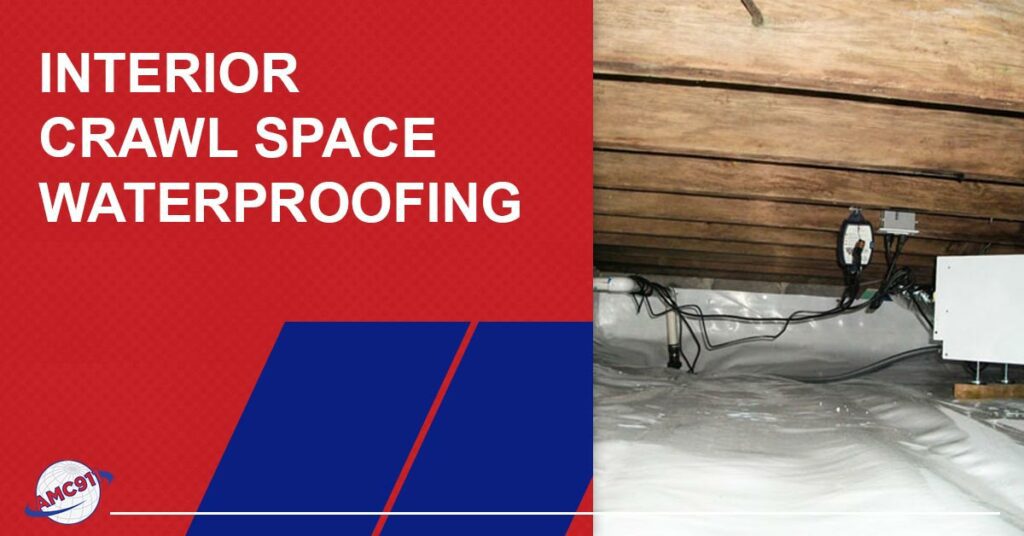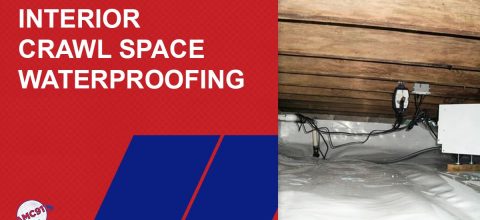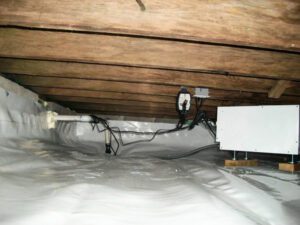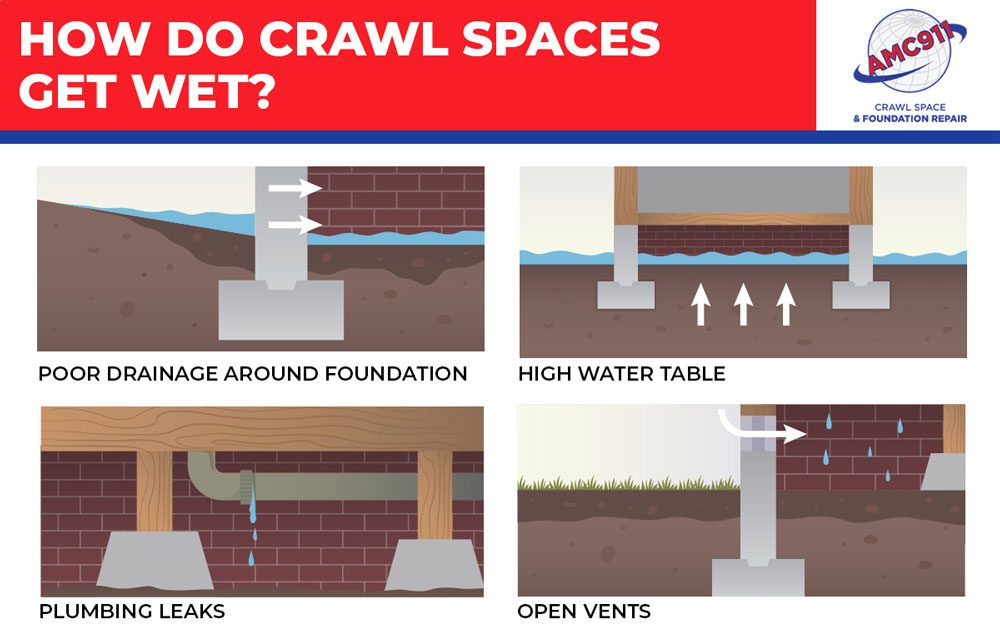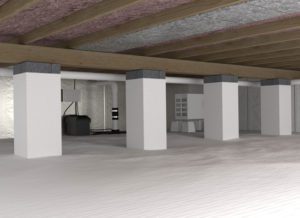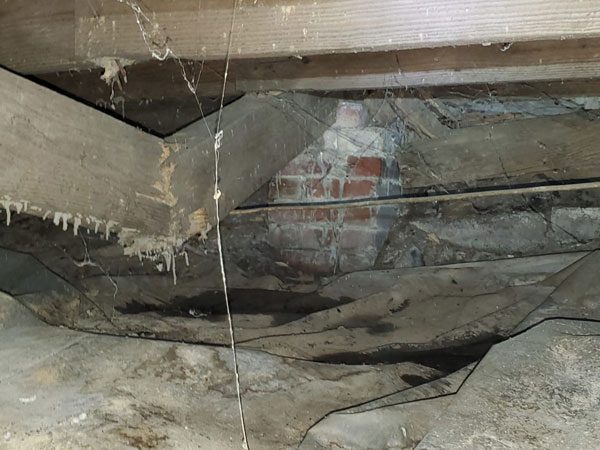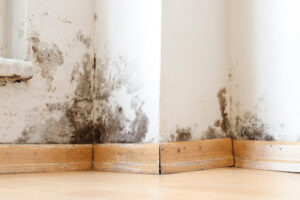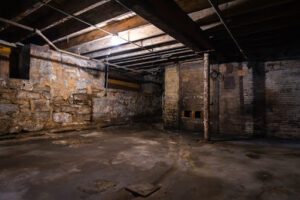Looking for information about interior crawl space waterproofing? If so, don’t hit that back button because you’ve landed on the right page. In this article, we’ll review interior crawl space waterproofing, why you might need it, how crawl spaces get wet, how interior crawl space waterproofing is done, and more.
What Is Interior Crawl Space Waterproofing?
Interior crawl space waterproofing is a technique that prevents moisture and water from infiltrating a crawl space and causing damage. This type of waterproofing involves installing a specialized drainage system beneath the crawl space floor. Another name for interior crawl space waterproofing is interior drain tile.
Interior crawl space waterproofing is typically implemented when there is already water damage or moisture in the crawl space. The installation involves digging a trench around the inside perimeter of the crawl space, which is then filled with gravel and a perforated pipe. The pipe is designed to capture and channel excess groundwater away from the foundation. We’ll talk more about the interior crawl space waterproofing installation procedure in just a bit.
Why Waterproof Your Crawl Space?
Here’s why crawl space waterproofing is essential for protecting your home:
- Mold grows in wet crawl spaces – A damp, dark crawl space is the perfect petri dish for growing mold. Mold can eat away at the wooden structures in your crawl space, and airborne mold spores can quickly spread to other areas of your home, causing allergic reactions and respiratory problems for the home’s residents.
- Prevent pest infestations – Wood-eating pests such as termites prefer a damp environment.
- Prevent wood rot – Wood rot is much less likely in a dry crawl space.
- Reduces hydrostatic pressure – When the soil around your home becomes saturated with water, hydrostatic pressure can build up and push against the foundation walls. Hydrostatic pressure is strong enough to push water through invisible cracks in the wall and into your crawl space. It can even cause cracks in a foundation wall, resulting in costly repairs.
- Improved air quality in your home – As noted above, moldy air in your crawl space means moldy air in your home’s living area. By waterproofing your crawl space, you can significantly improve the air quality within your home.
How Do Crawl Spaces Get Wet?
Crawl spaces get wet for various reasons, including the following:
- Poor drainage around the foundation – This causes hydrostatic pressure to build up and push water through invisible cracks in the foundation wall.
A high water table -If the home is in an area with a high water table – like - Hampton Roads – groundwater may seep into the crawl space through the dirt floor. Homes situated near bodies of water, such as lakes or rivers, are more susceptible to this issue.
- Plumbing leaks – Pipes may burst or leak within the crawl space, leading to standing water or high humidity levels.
- Open vents – Open crawl space vents allow warm, humid air to flow in and condense on cooler surfaces.
For more information, see What Are Crawl Space Jacks And When Do You Need Them?
Why Interior Waterproofing?
One big benefit of interior waterproofing is that it doesn’t require excavation. In contrast, exterior waterproofing requires excavation to expose the foundation walls. That’s a lot of work. Therefore, interior crawl space waterproofing is easier and less expensive than exterior waterproofing. It can be done quickly and without major disruptions to your daily routine.
How Is Interior Waterproofing Performed?
The following essential steps should be followed during the installation procedure for interior crawl space waterproofing.
- Inspection and assessment – The first step in installing interior crawl space waterproofing is inspecting and assessing the area. This involves checking for moisture and damage that can affect the integrity of the foundation and walls. This process helps determine the best waterproofing approach.
- Repair and maintenance – Before waterproofing, any damage must be repaired. This might involve fixing cracks and leakages, replacing damaged pipes, clearing debris in the crawl space, etc. This ensures that the waterproofing measures work effectively.
- Dig a trench – A shallow trench is now dug around the inside perimeter of the crawl space and lined with gravel.
- Drainage installation – The next step is to lay down the perforated drainage pipe on top of the gravel and then cover the pipe with more gravel. The drainage pipe will redirect excess groundwater toward a sump pit, which will then be expelled from the foundation via a sump pump.
Option crawl space encapsulation and a dehumidifier
After the drainage system is in place, many homeowners choose to encapsulate their crawl space and add a dehumidifier. Crawl space encapsulation involves sealing the vents and covering the crawl space floor and walls with a vapor-retarding barrier. This prevents moisture from entering the crawl space through the dirt floor or walls. A dehumidifier is added to ensure the humidity level in the crawl space remains low.
Interior crawl space waterproofing should always be carried out by professionals to ensure that all components adhere to the recommended standards.
Signs You Might Need Crawl Space Waterproofing
Signs you might need crawl space waterproofing include the following:
- Your home smells musty – If there’s a musty odor in your house, it might be because there’s mold in your crawl space, which means moisture.
- There’s visible mold in the crawl space – This is a sure sign of excess moisture.
- There’s wood rot – A damp crawl space makes wood rot more likely.
- There’s standing water in the crawl space – This one needs no explanation.
- There’s condensation inside your home – This could be because the humidity level in the crawl space is high.
- The floor above the crawl space is moldy – There’s probably mold in your crawl space, which means moisture.
If you think your home might need interior crawl space waterproofing, contact AMC911 today to schedule a crawl space evaluation and receive a repair estimate.

